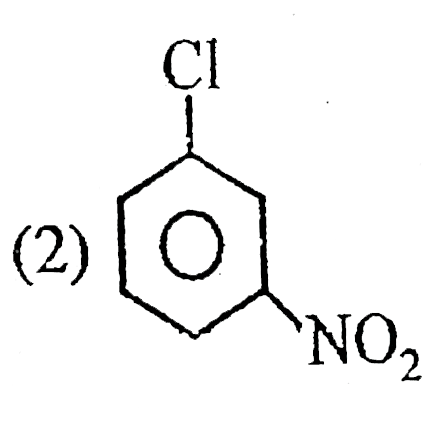Which one of the following compounds will be most
readily hydrolysed in aqueous alkali?




The correct Answer is:C
To determine which compound will be most readily hydrolyzed in aqueous alkali, we need to analyze the structures of the given compounds and the effects of substituents on the benzene ring. Hydrolysis in aqueous alkali involves a nucleophilic substitution reaction, and the presence of electron-withdrawing groups can significantly influence the reactivity of haloarenes.
1. Identify the Compounds:
Let's denote the four compounds as A, B, C, and D. Each compound has a halogen (Cl) attached to a benzene ring and may have electron-withdrawing groups (EWGs) like NO2 at different positions (ortho, meta, para).
2. Understand Hydrolysis in Aqueous Alkali:
Hydrolysis in this context refers to the substitution reaction where the halogen is replaced by a hydroxyl group (OH). The rate of hydrolysis depends on the stability of the intermediate carbocation formed during the reaction.
3. Analyze the Position of Electron-Withdrawing Groups:
- Compound A: Has NO2 at the ortho position. This will exert both -I (inductive) and -R (resonance) effects, enhancing the electron-withdrawing nature.
- Compound B: Has NO2 at the meta position. Here, it only exerts -I effect and does not contribute to resonance stabilization of the carbocation.
- Compound C: Contains two NO2 groups at the meta position. Both groups exert -I effects but do not stabilize the carbocation through resonance.
- Compound D: Has NO2 groups at both ortho and para positions. This configuration allows for both -I and -R effects from both groups, significantly increasing the electron-withdrawing ability.
4. Determine the Compound with the Highest Electron-Withdrawing Effect:
The compound with the strongest electron-withdrawing effects will stabilize the carbocation formed during hydrolysis, making it more reactive.
- Compound A (ortho NO2) has a strong effect.
- Compound B (meta NO2) has a weaker effect.
- Compound C (meta NO2, two groups) has a moderate effect.
- Compound D (ortho and para NO2) has the strongest effect due to the combined -I and -R effects from both positions.
5. Conclusion:
Based on the analysis, Compound D, which has NO2 groups at both the ortho and para positions, will undergo hydrolysis most readily in aqueous alkali due to the strong electron-withdrawing effects.
Final Answer:
The compound that will be most readily hydrolyzed in aqueous alkali is Compound D.
Let's denote the four compounds as A, B, C, and D. Each compound has a halogen (Cl) attached to a benzene ring and may have electron-withdrawing groups (EWGs) like NO2 at different positions (ortho, meta, para).
Hydrolysis in this context refers to the substitution reaction where the halogen is replaced by a hydroxyl group (OH). The rate of hydrolysis depends on the stability of the intermediate carbocation formed during the reaction.
- Compound A: Has NO2 at the ortho position. This will exert both -I (inductive) and -R (resonance) effects, enhancing the electron-withdrawing nature.
- Compound B: Has NO2 at the meta position. Here, it only exerts -I effect and does not contribute to resonance stabilization of the carbocation.
- Compound C: Contains two NO2 groups at the meta position. Both groups exert -I effects but do not stabilize the carbocation through resonance.
- Compound D: Has NO2 groups at both ortho and para positions. This configuration allows for both -I and -R effects from both groups, significantly increasing the electron-withdrawing ability.
The compound with the strongest electron-withdrawing effects will stabilize the carbocation formed during hydrolysis, making it more reactive.
- Compound A (ortho NO2) has a strong effect.
- Compound B (meta NO2) has a weaker effect.
- Compound C (meta NO2, two groups) has a moderate effect.
- Compound D (ortho and para NO2) has the strongest effect due to the combined -I and -R effects from both positions.
Based on the analysis, Compound D, which has NO2 groups at both the ortho and para positions, will undergo hydrolysis most readily in aqueous alkali due to the strong electron-withdrawing effects.
The compound that will be most readily hydrolyzed in aqueous alkali is Compound D.
Topper's Solved these Questions
- TEST PAPERSBOOK - ALLENCHAPTER - TEST PAPERSEXERCISE - part-2Chemistry
21 Videos
- TEST PAPERSBOOK - ALLENCHAPTER - TEST PAPERSEXERCISE - part-2 Chemisty
18 Videos
- TEST PAPERSBOOK - ALLENCHAPTER - TEST PAPERSEXERCISE - PAPER 1
60 Videos
- TEST PAPER 4BOOK - ALLENCHAPTER - TEST PAPER 4EXERCISE - CHEMISTRY
45 Videos
- THERMODYNAMICS BOOK - ALLENCHAPTER - THERMODYNAMICS EXERCISE - EXERCISE -4
18 Videos
Similar Questions
Knowledge Check
Which of the following compounds is most readily nitrated ?
AbenzeneBphenolCtolueneDnitrobenzeneWhich one of the following compounds would form most stable hydrate?
ACl3C−O∣∣C−HBH3C−O∣∣C−HCF3C−O∣∣C−CF3DH−C∣∣O−H
Which one of the following compounds is most acidic
View SolutionWhich one of the following compounds is most acidic
View SolutionTo which of the following compounds H2 adds most readily?
View SolutionWhich one of the following compounds has the most acidic nature ?
View SolutionWhich of the following compounds can be hydrolysed?
View SolutionWhich one of the following compounds possesses the most acidic hydrogen?
View Solution
